Three Building Blocks, Two Missed Opportunities, and One Recommendation. A Review of the 62nd International Festival of Contemporary Music “Warsaw Autumn”
The words “Warsaw Autumn is a brand” accidentally fall into my ear when I pass a chatting group during a break between the concerts. I read “Warsaw Autumn is a witness of history” as I am skimming a press note promoting the festival in a mainstream Polish magazine. It makes me think of my own research on the history of the Polish contemporary art music scene. Many times I have described Warsaw Autumn as “a unique point on the map of Eastern Europe” in order to justify the significance of my research topic to the academic world, or to explain it to someone who does not know the history of European avant-garde music.
What we mean when we talk about Warsaw Autumn as a “brand,” a “witness of history,” and a “unique point on the map of Eastern Europe” is that, in addition to a yearly overview of the trends in contemporary art music, Warsaw Autumn’s significance is based on at least three building blocks. These three intertwined dimensions of the festival’s status are its prestige, ancestry, and geopolitical importance. And all three go back to 1956, when the festival was founded. Warsaw Autumn emerged as a result of intense negotiations between the Polish Composers’ Union representatives seeking to overcome the socialist realist isolation and open Poland to the avant-garde scene and the communist authorities seeing socio-political and diplomatic potential in launching a prestigious international music festival. In the following decades, Warsaw Autumn functioned in a condition of what could be termed “supervised subversiveness.” On the one hand, a crack in the Iron Curtain was unprecedented in the region and facilitated cultural exchange with the Western music world, but on the other, the festival was subject to the authorities’ censorship and program quotas when necessary.1 Warsaw Autumn survived communism and after its collapse the festival managed to adapt to the new reality of capitalism. It can be said that the meaning of the Warsaw Autumn’s prestige, ancestry, and its role in the world has evolved with time, political situation, and subsequent festival directors.
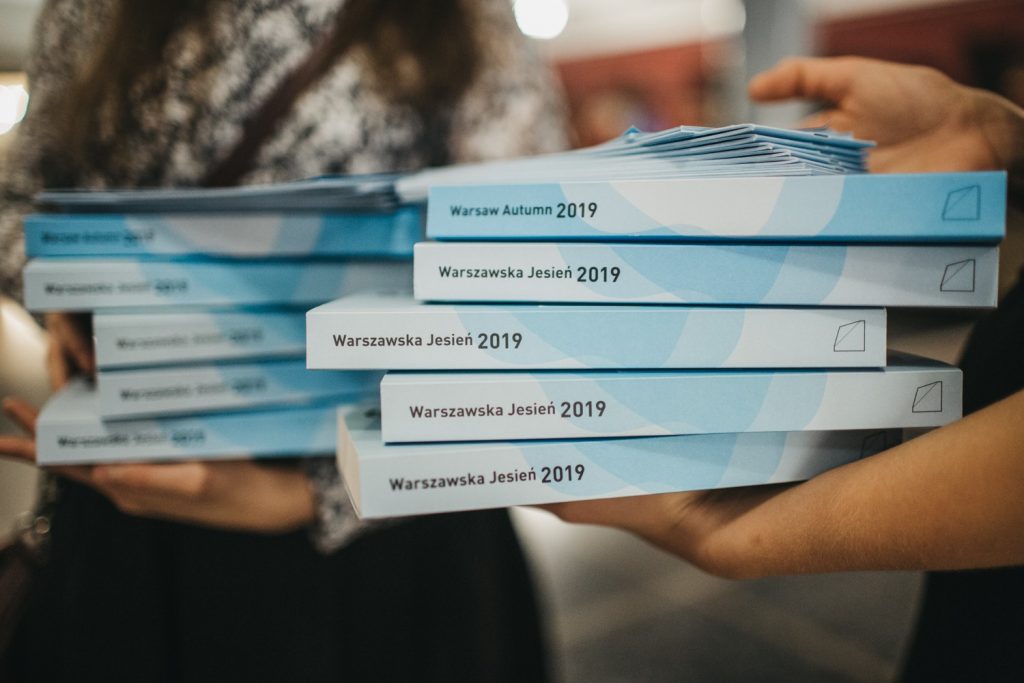
„Warsaw Autumn” booklet, photograph: Grzegorz Mart/International Festival of Contemporary Music “Warsaw Autumn”.
As Polish critics have already noted, one of the festival’s biggest challenges is to find an updated meaning for its three building blocks. What potential do they bring? Can Warsaw Autumn’s prestige do more than justify its elitism? Can the festival’s communist ancestry with its anxiety over the “overpoliticization” of contemporary art music be reconciled with the new need for its socio-political engagement? As the unique “window-to-the-world” status of the festival no longer seems relevant in times of free movement across EU borders, is Warsaw Autumn ready to critically reflect on the current geopolitical reality? As of 2019, it remains unclear in what direction the festival is heading and how it envisions itself. There is a lot of creative potential in this uncertainty, and it seems that I am not the only one who is looking forward to seeing how the Warsaw Autumn will evolve in the coming years (unless the organizers decide to give in to a sheltering stagnation). That being said, there are also great risks involved, which will be explored in more detail further.
Block one: the prestige
The 62nd International festival of Contemporary Music “Warsaw Autumn” offered its audience a diverse 9-day program featuring four orchestral concerts, two music theater productions, five small and medium ensemble concerts (including two wonderful contemporary music ensembles: the London-based Plus-Minus Ensemble and a young promising Polish group Ensemble Kompopolex), film screenings, meetings with composers, four composition workshops (which were a first-rate opportunity for young aspiring composers), two mini exhibitions, a sound installation, and a handful of accompanying events. Additionally, the festival maintained its two additional program lines well known to the festival audience: Little Warsaw Autumn—a set of events dedicated to young audiences—and two late-night concerts of a “Warsaw Autumn Hits the Club” series organized in a more relaxed club-like setting. Each afternoon, music critics Monika Pasiecznik and Tomasz Biernacki, together with invited guests, commented on the current festival events on the festival Web Radio.
Like every year, Warsaw Autumn prepared an attractive program for the lovers of symphonic sounds, usually based in a more conventional contemporary music aesthetics with the occasional use of electronics. The opening concert on September 20 at the Warsaw Philharmonic featured two works commissioned from the Polish composers of the older generation: Zygmunt Krauze’s Piano Concerto no. 3 Fragments of Memory and Magdalena Długosz’s On the Edge of Light for large symphony orchestra with extensive percussion and a live electroacoustic layer. Długosz’s extended and refined composition explored what she calls a “polyphony of sonic fields,” allowing listeners to experience the spatial dimension of music and a full immersion in sound. The texture of multiple thick layers, which were accompanied by improvised electroacoustics, stayed with listeners in the subsequent piece Flutter by the Icelandic composer Thuridur Jónsdóttir, only instead of live electronics there was a recording of insects in their natural habitat. The narrative through-line of the concert was provided by three organ improvisations by the Danish composer and organist Morten Ladehoff. Alternating with the large setting pieces by Bruno Mantovani (sharp and dense orchestral music organized into consecutive contrasting blocks), Krauze, Długosz, and Jónsdóttir, Ladehoff’s short musical interludes were witty and concise commentaries on the stylistic features of each preceding piece.
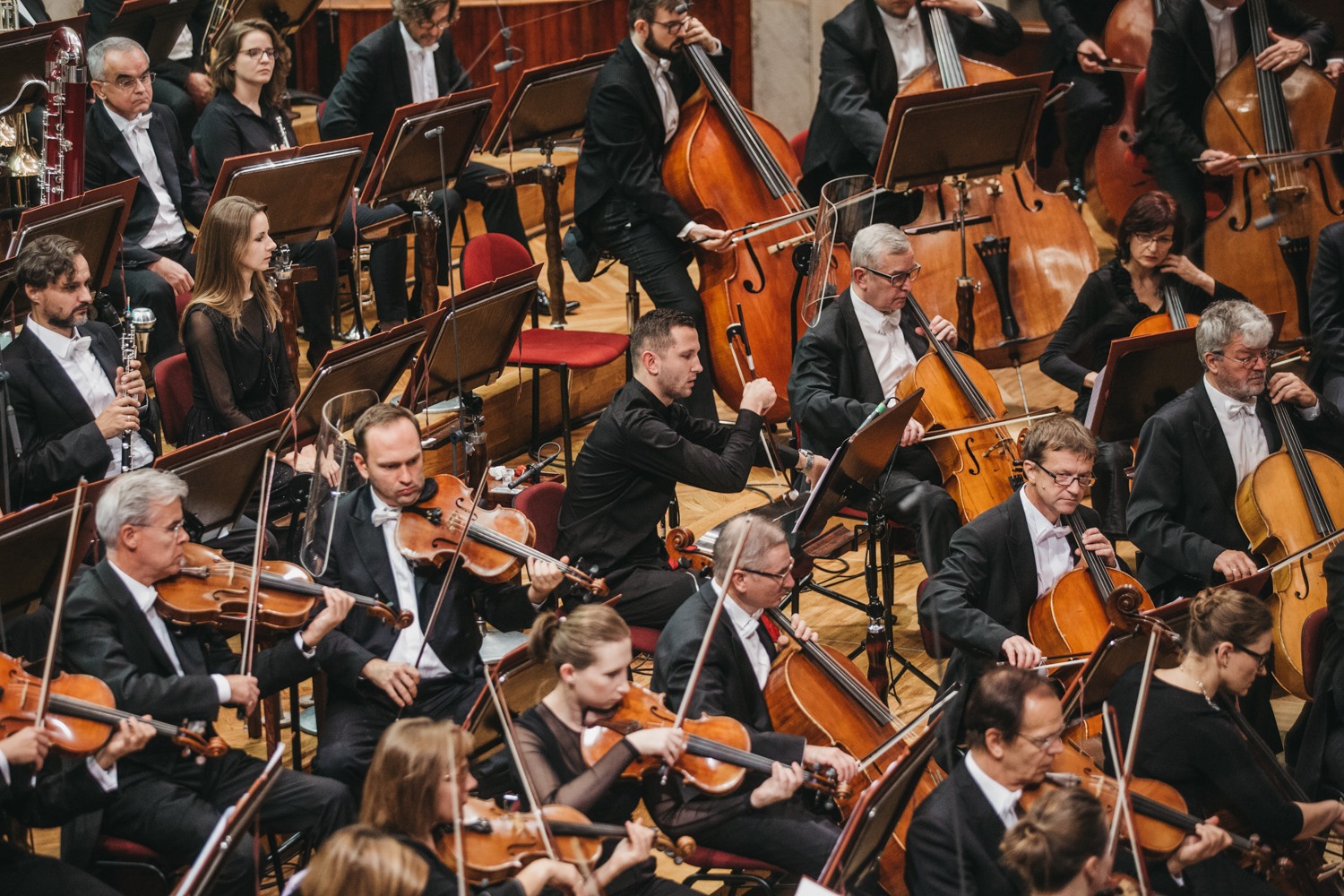
Opening concert, September 20, 2019, photograph: Grzegorz Mart/International Festival of Contemporary Music “Warsaw Autumn”
There were at least two common threads linking the opening and the closing concerts (the latter took place on September 29 at the Warsaw Philharmonic). One thread was the use of the spoken word. In his Piano Concerto no. 3, Zygmunt Krauze—in the double role of composer and soloist—expressed his protest against the injustice of the modern world by shouting out short words with a faltering voice while performing the piano part. The closing concert featured Tadeusz Wielecki’s Anamnesis (Warsaw Autumn’s commission as well), which was composed around spatial—but also musical—terms: width, length, height, and depth. The different dimensions were illustrated by orchestra and additionally recited by Wielecki in the superimposed recording. Another parallel between the concerts were contrasting virtuosic parts of flute (animated rustles in Jónsdóttir piece, the flute part performed by Mario Caroli) and trumpet (Marco Blaauw operating between subtle, mysterious sounds, and loud blusters in Rebecca Sanders’s Alba).
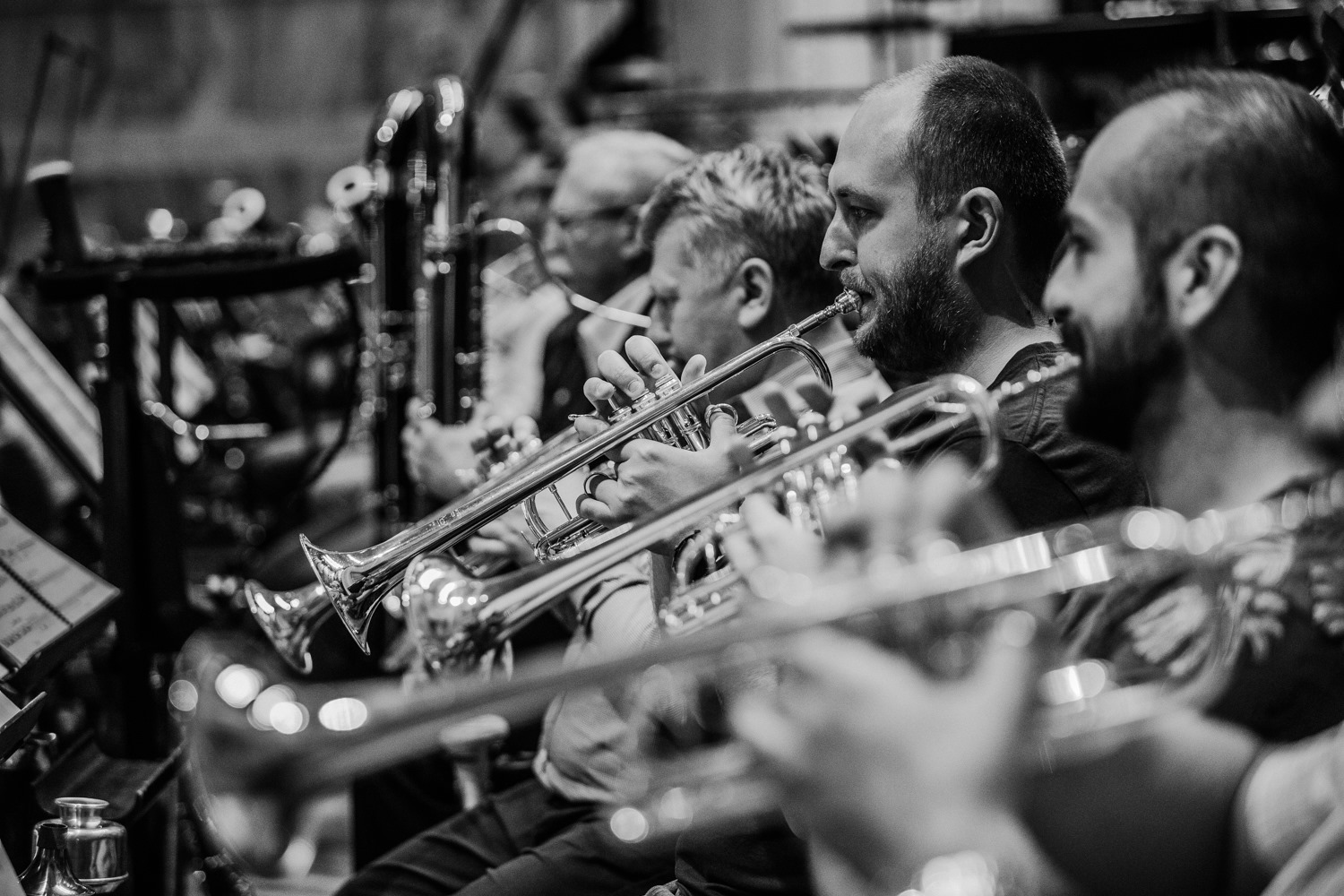
Closing concert, September 28, 2019, photograph: Grzegorz Mart/International Festival of Contemporary Music “Warsaw Autumn”
In addition to the festival commissions and Polish premieres of recent compositions by European composers, Warsaw Autumn showcased some of the most appreciated contemporary music “classics:” Sofia Gubaidulina’s Sonnengesang from 1997 (the fantastic Camerata Silesia singers directed by Anna Szostak and complimented by Marcin Zdunik on solo cello), Tristan Murail’s Le Lac performed by the European Workshop For Contemporary Music, and the cherry on top of the festival cake, Iannis Xenakis’s Jonchaies from 1977 performed by the Katowice Polish National Radio Symphony Orchestra at the closing concert (which received three curtain calls!).

Marcin Zdunik and Camerata Silesia, September 24, 2019, photograph: Grzegorz Mart/International Festival of Contemporary Music “Warsaw Autumn”
Another highlight of this year’s Warsaw Autumn was the music brought by young interdisciplinary artists from Belgium, Netherlands, and Denmark. One of the festival’s biggest successes was the Sound Ritual concert at the New Theater. In Wings by Cathy van Eck and Tubes by Paul Craenen, the Dutch artists explored the materiality of acoustic feedback that occurred between the microphones and loudspeakers. The pieces examined the relationship between sound and object, while blurring the lines between a theatrical performance and a sound installation. Niels Rønsholdt, a Danish composer of the same generation, came to Warsaw with his semantically multi-layered experimental opera production Gaze for Gaze (2017), which explores the idea of life paths that we do not choose and leave unlived. Rønsholdt integrates the audience into the piece, inviting listeners to sit in a circle (bringing to mind a therapy support group) surrounding two instrumentalists located at a rotating platform and to read aloud sentences they find on their chairs. The piece was structured as a universal break-up story between a woman and a man (with an unclear but pertinent reference to abortion), relying on formal elements of early opera (e.g. Baroque recitative) and ancient Greek theater (the role of the choir). Another great contribution came from the Danish composer Simon Løffler. In his mysteriously titled pieces b and H he composed human performers, mechanical objects, sounds, and light into an integrated sonic machine, subjecting the role of performers to the electric and mechanic forces of the objects.

Scenatet, September 21, 2019, photograph: Grzegorz Mart/International Festival of Contemporary Music “Warsaw Autumn”
Block two: the ancestry
As noted above, the long and rich ancestry of the Warsaw Autumn Festival adds to its high esteem. But it is the same long and rich ancestry that is currently luring Warsaw Autumn into a trap. One of the fields where Warsaw Autumn’s difficult historical ancestry of the communist era manifests itself the most clearly is the festival’s engagement with the social. What I mean by “the social” is all kinds of extra-musical surroundings, individual and collective ideas, concerns, fears, hopes, joys, and problems that permeate public discourse and that many members of the festival’s audience bring into the festival space.
Warsaw Autumn’s fluctuating relationship with the social is reflected in the trilogy of themes of the editions between 2017-2019. Jerzy Kornowicz and his program committee came up with three themes before the new director’s first festival in 2017. The trilogy seems to be governed by the following logic: the musical (the 60th anniversary edition in 2017 under the “Trans/Avant-gardes” theme, exploring the evolution of musical avant-garde), the socio-political (the 2018 edition under the theme of “Res publica,” tapping into the communitarian dimension of contemporary music and referring to the 100th anniversary of Poland regaining its independence), and the spiritual: the 2019 festival was organized around the enigmatic term “Pneuma” (relating to “expanded reality / air / space / time / matter / nature / vitality…”2 or, in other words, everything and nothing).
While organizing festivals under annual themes is a common and justified practice, it appears that Warsaw Autumn’s program committee employs festival themes in order to compartmentalize music’s dimensions (aesthetic, sonic, political, spiritual) that naturally tend toward a synthesized co-existence. As a result, against the various themes declared year by year by the program committee, the reality of the festival looks more or less like this: certain “safe” elements of the contemporary music experience (such as the abstract sonic dimension) have a permanent place in the festival discourse, whereas the ones that seem sensitive or risky are subject to check-box politics. The uncomfortable parts are usually the ones directly referring to socio-political reality, and the festival organizers tell us exactly why that is:
“In Poland and elsewhere in Central and Eastern Europe, such disinterestedness [with the surrounding reality] is deeply rooted amongst composers as well as part of the audience. The postwar history of Poland has brought many examples of the outside world intervening into art. (…) Authoritarian pressure on artists put most composers and listeners off the official public sphere, while intensifying the need to hide away in a “pure,” ideal, separate sphere: one of the niches where freedom, albeit with some limitations, was possible.”3
This approach is very much alive among those who currently conceptualize Warsaw Autumn, as revealed in the public debate (or, to be more accurate, a round-table semi-formal discussion among festival insiders with almost no attendance of the general public) that took place on September 28, the final day of the festival, at the Austrian Cultural Forum. Several among the organizers, composers, and academics present in the room seemed very anxious when asked about the festival’s response to gender inequality in music and the seriousness of the climate crisis (reflected by the crowds of strikers filling Warsaw’s streets two blocks away from the Philharmonic Hall). Some wanted Warsaw Autumn to be “a space to take a rest from the political noise,” others were concerned that imposing a gender quota on the festival program reminds them too much of the ‘70s, when the communist authorities dictated the festival program. Questions about environmental awareness were reduced to absurdity and shrugged off with a simple “all that composers can do is to write good music.” Moreover, it is not surprising that the anxiety over the so-called “overpoliticization” of music (isn’t the declaration of apoliticism inherently political?) seems to overlap with another type of anxiety, namely the one caused by the increasing role of video and theater in contemporary music. Both of them threaten the safe shelter of music’s “purity,” where mythological artistic freedom is promised to be located.
While many claim that to keep Warsaw Autumn’s status quo is to limit the political, what we heard in Warsaw in September clearly shows that composers, as much as the listeners (and who knows, perhaps some of the organizers themselves?), are in fact very interested in exploring the territories beyond abstract sound and structural listening.
The use of video material—with the predominance of YouTube video culture—in the pieces by Marta Śniady, Agnieszka Stulgińska, Jacek Sotomski, and Sławomir Wojciechowski represented a strong post-internet (net-aware) theme in this year’s festival and allowed for a deeper expressive engagement with extra-musical issues. Sławomir Wojciechowski’s Handmade was the most compelling piece of the Friday late night concert held at the Warsaw Philharmonic Chamber Hall (following the symphonic concert that opened the festival earlier that evening). Chainsaws cutting computer screens in half and a machine gun leaving holes in a row of freshly unpacked new iPhones are just some of the many tragicomic images presented in Handmade, representing the fetishization of waste, which is a highly popular trope on YouTube. Wojciechowski makes a bold statement about the absurd level of consumerism with its YouTube culture of unboxing videos and the destructive force of overproduction. The only drawback of Handmade was that the brilliant visual layer was synchronized with the tangible, sensuous sounds so well that it completely stole the show from the fantastic Plus-Minus Ensemble. Or maybe we were set up by the composer to switch to unconscious listening for the sake of the greedy visual consumption of destruction?
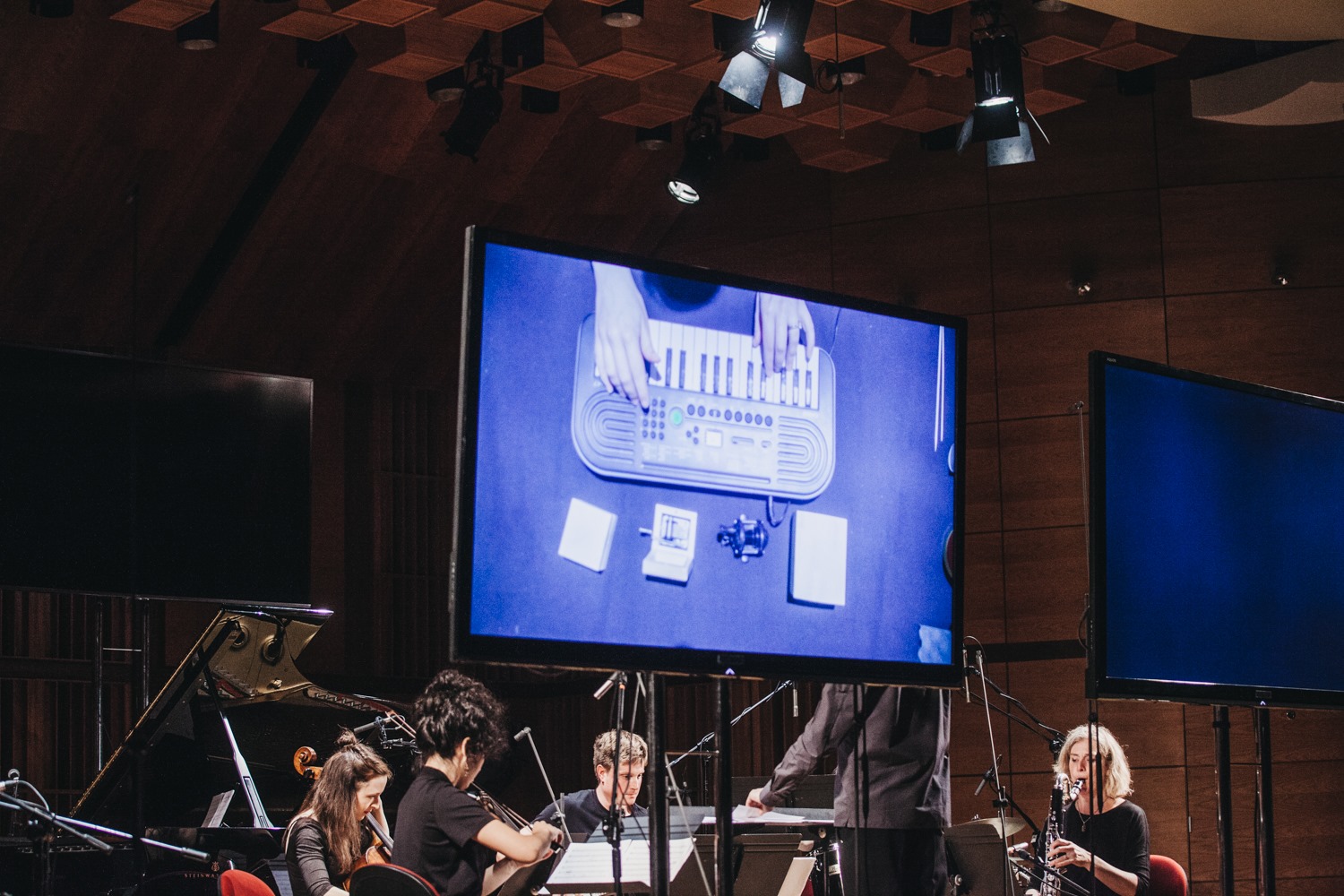
Plus-Minus Ensemble, September 20, 2019, photograph: Grzegorz Mart/International Festival of Contemporary Music “Warsaw Autumn”
A different approach to the music-video relationship was taken by Marta Śniady, who consciously manipulated listeners’ attention by alternating fragments with and without video in her pieces. The narrative of Śniady’s 2017 piece c_utle_#1 (presented at the Witold Lutosławski Polish Radio Concert Studio on September 27) builds on the tension and contrast between the representations of the words cut and cute. Her range of expressive tools vary from the decisive, blown-and-let-go sound blocks (cut) through baby cat videos displayed on the screen (cute) to the use of scissors as a percussion instrument (cut). At the same time, the recording of Yoko Ono’s Cut Piece fragments juxtaposed with a tiger’s deadly attack on a giraffe point to a deeper level of interpretation, reflecting on the fragility of the female body as a target to predators.
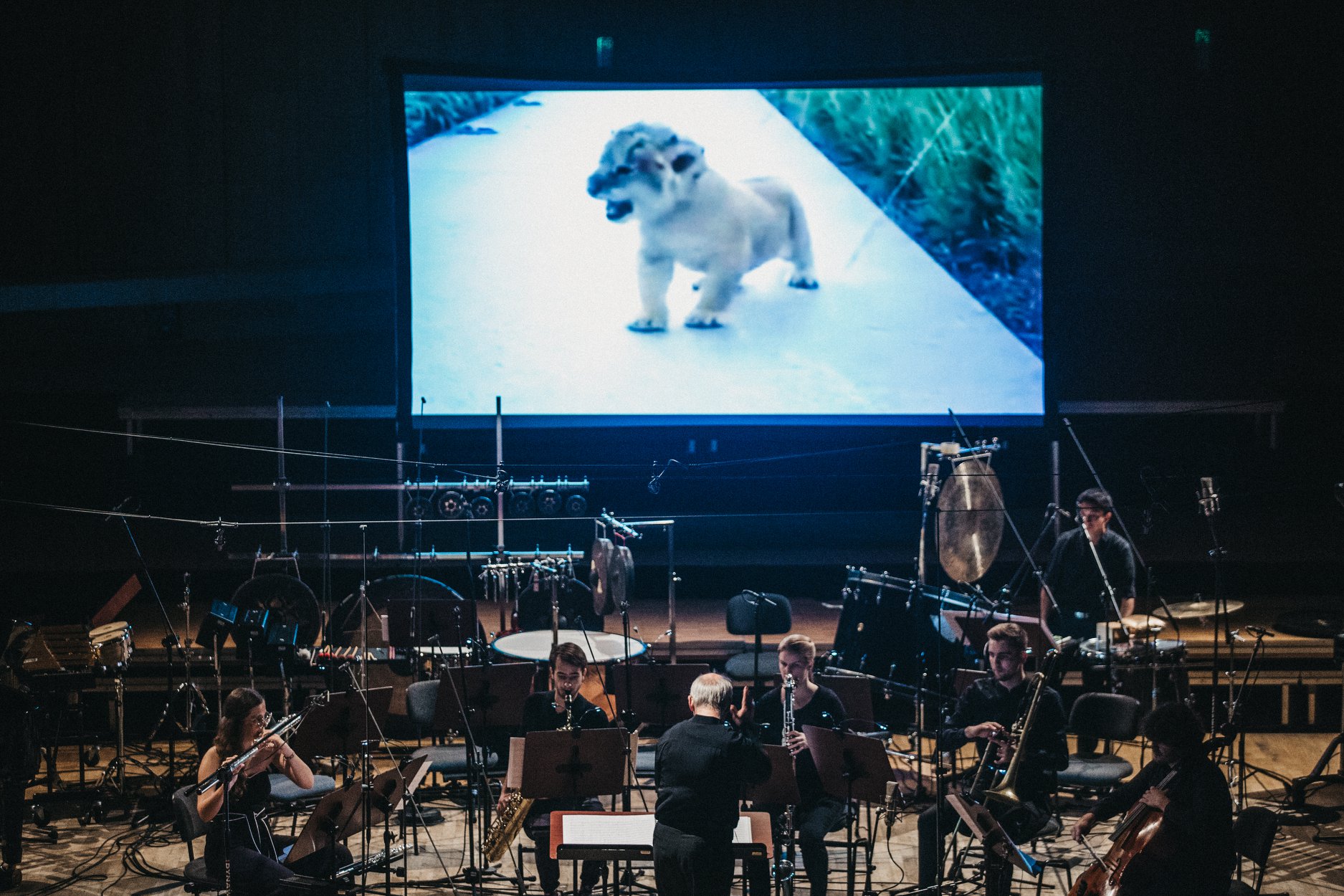
Marta Śniady c_ut|e_#1, September 27, 2019, photograph: Grzegorz Mart/International Festival of Contemporary Music “Warsaw Autumn”
It is worth noting that Wojciechowski’s piece followed another brilliant work by the young London-based Polish composer Monika Dalach. In Shout #1-3, Dalach brings together a chamber ensemble, electronics, TV screens, and pantomime in order to explore the intimate tensions between bodily-expressive silence and electronically-processed music quotations from the Tears and Fears’ 1984 song Shout, accompanied by percussion, electric guitar, violin, cello, and clarinet. Dalach manages to combine in her piece a nostalgic trip to the background music of her childhood, the accompanying flagship analog recording systems of the ‘80s and ‘90s (VHS), and a psychological study on the bodily and sonic expression of human emotion.
The piece that was the most original, engaging, and rich in contexts (and in my opinion one of the best pieces of the entire festival) was Jacek Sotomski’s Credopol, which was performed by the Kompopolex Ensemble at the Imka Theater. Credopol is not a composition that should be summarized and reviewed; it is a composition that should be experienced. But let me say that I have not heard or seen in a while an artistic undertaking that would approach the key absurdity of everyday online and offline Poland with so much perceptiveness, intelligence, humor, and virtuosity. That same evening, we heard the two aforementioned pieces by Simon Løffler. The opening and closing pieces of this concert were two premieres commissioned by Warsaw Autumn: FMYF and OMYM by Agnieszka Stulgińska, who created an intimate setting with a sonic layer and a video of a dog in order to refer to the questions of human condition and the ability to show emotions.
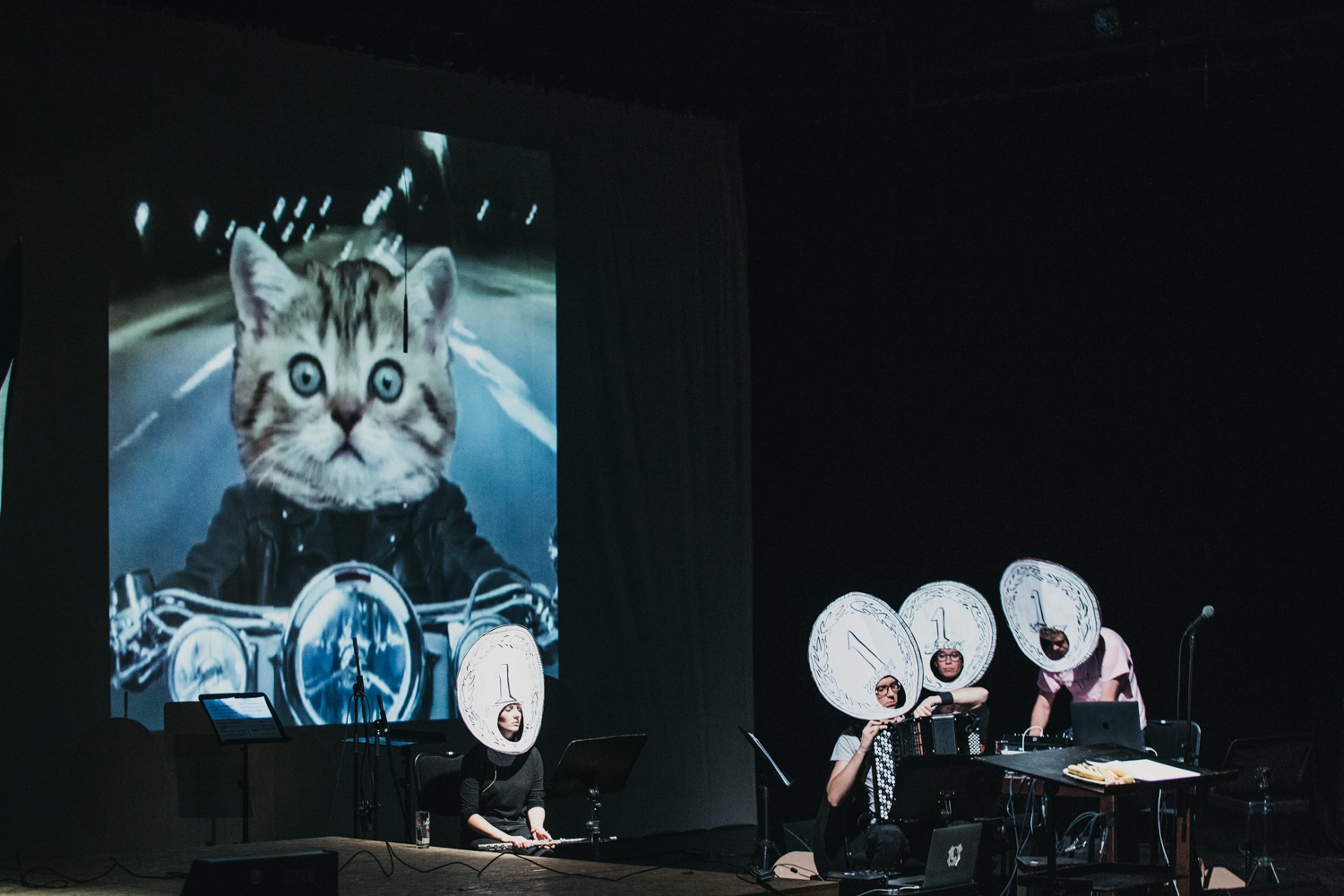
Ensemble Kompopolex, September 23, 2019, photograph: Grzegorz Mart/International Festival of Contemporary Music “Warsaw Autumn”
On Wednesday night the IRCAM-produced experimental music theater mega-production Thinking Things by Georges Aperghis was presented at the ATM Studio with purpose-built robots. The work focused on the modern anxieties in face of the growing role of artificial intelligence. Aperghis’s theatrical piece was one of the festival’s most interdisciplinary takes on contemporary music culture, one that was very far from the “pure music” ideal. The robotic sonic layer functioned on a par with image and gesture. Ironically, to some extent it resonated with the uneasiness linked to the growing role of technology, processed sounds, and the internet in musical culture.
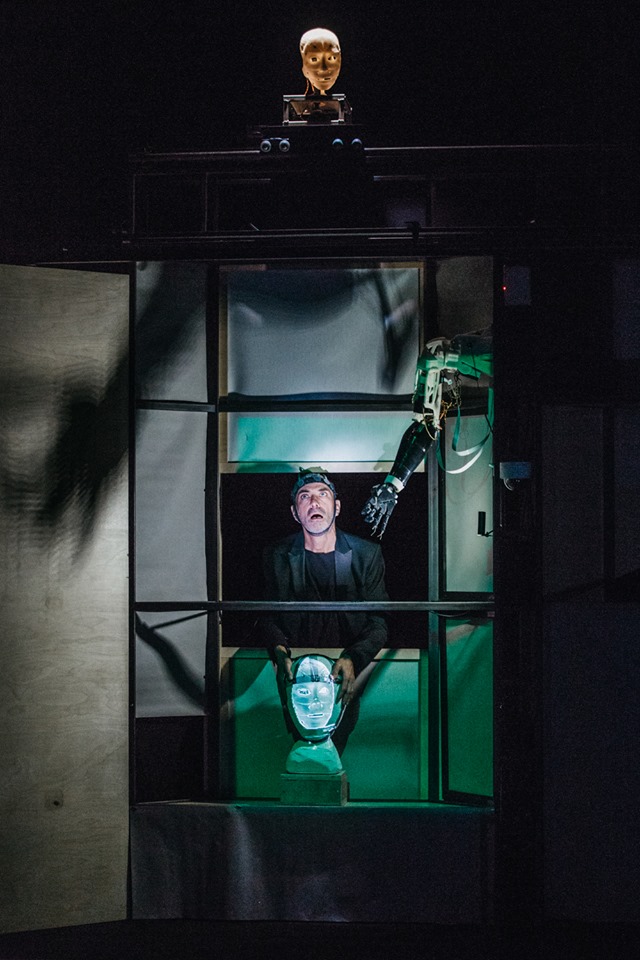
Richard Dubelski, September 25, 2019, photograph: Grzegorz Mart/International Festival of Contemporary Music “Warsaw Autumn”
Finally, in Hearing Sirens, the closing piece of the aforementioned concert at the New Theater, Cathy van Eck led the audience out of the concert hall and into the hallway with two giant yellow loudspeakers on her shoulders. As the composer writes in the program note, she wanted to perform a situation opposite to our everyday participation in the public space, when we use earphones to play music exclusively into our ears.

Cathy van Eck, September 26, 2019, photograph: Grzegorz Mart/International Festival of Contemporary Music “Warsaw Autumn”
The engagement with the social is clearly already there, despite the anxieties surfacing in the festival discourse and despite the missed opportunity to apply its full potential and take the conversation further. Returning to the Warsaw Autumn’s relationship with its ancestry, it seems that overcompensation for the difficult history of the musical-social relationship during the communist period is not the only reason why the festival is so cautious with embracing what we might call “the social.” The problem may also lie in an outdated understanding of avant-garde’s critical potential. It is possible that the Warsaw Autumn misplaces its hopes of being progressive (and maybe even radical) and locates them in postmodern music’s false promises of radical progressiveness. What I mean here is, after Georgina Born, a larger problem with how avant-garde has been conceived as a stand-in for actual social change. As Born writes:
“Pluralism is central to the way that postmodern intellectuals experience the aesthetic imaginatively as progressive, aesthetic pluralism is divorced from extant socioeconomic differences and held to be an autonomous and effective force for transforming those differences. The aesthetic is held to portend social change; it can stand in psychically for wider social change. In this sense, cultural postmodernism can be seen as an ideology tout court in the classic sense of a cultural system that conceals domination and inequality.”4
Born is saying two important things here. First, postmodernism in music brought fantasies of an absolute eclecticism, where high music becomes fully open to both the musical “other” (e.g. “the low,” popular culture, or non-musical media) and the ethnic “other” (e.g. folk music). Through a postmodern lens the broadly understood musical avant-garde is expected to go beyond power dynamics and the core-periphery division. Second, the narrative of absolute eclecticism—which originally referred to musical genres—has subsequently been transferred to feed the collective imagination with fantasies of post-difference and total inclusivity referring to who is given a voice in the broad contemporary art music culture.
The problem with such an approach to avant-garde is that the belief in its automatic, default inclusivity prevents Warsaw Autumn organizers from undertaking real and responsible actions of recognizing and including the festival’s “others.” Who do I mean by the festival’s “others”? First and foremost, people from outside of the immediate contemporary art music circle, new audiences interested in culture, but who need more guidance through the jungle of jargon and concert hall etiquette. Second, including female, queer, and ethnically diverse composers from varied cultural backgrounds (especially those who—heaven forbid—might be addressing social inequalities in their music), and in the same vein reaching out to diverse audiences. While Warsaw Autumn refers to the heritage of the avant-garde as well as the avant-garde’s critical potential, such a symbolic reference is insufficient to ground the festival as a socially-meaningful event. It is doubtful whether contemporary festivals of contemporary art music can be progressive, innovative, and set new trends without getting their hands dirty and recognizing the issues with social representation in music; that is, to remain relevant without breaking from the post-Romantic elitist fantasy of pure musical abstraction. In other words, if we feel reassured and easy when we leave the concert hall each night, if the Festival experience does not interfere with our comfort zone even once, aren’t we missing out on the actual critical potential that Warsaw Autumn could have today?
Block three: the geopolitical location
The question remains: how to restructure Warsaw Autumn’s relationship to its historical ancestry without harming said ancestry’s power of legitimizing the festival’s status in the music world? We can find the answer by looking closer at the third building block: the geopolitical location. I do not believe that Warsaw Autumn’s unique status under communism came just from the fact that it was the only platform in the Eastern Bloc where a large-scale contemporary music exchange was possible. The unique role of the festival also came from its community-building potential. Warsaw Autumn was not only consolidating the composers’ milieu across Poland and internationally across the geopolitical divisions, but also its audiences. Warsaw’s citizens awaited the festival with impatience and buses of tourists arrived from other countries of the Eastern Bloc for the festival. The times have changed dramatically and the festival is no longer so unique, but the community-building potential is still there. If I had the opportunity to give Warsaw Autumn’s organizers just one piece of advice, I would say: help it grow. To do this, organizers must start at the ground level and meet people where they are at.
Initiatives such us “Little Warsaw Autumn,” “Warsaw Autumn Hits the Club” as well as attempts to hold open meetings with the public prove that Jerzy Kornowicz and his colleagues are interested in democratizing the festival and reaching new audiences. But, analogically to their claim of inclusivity and opinion-forming potential, simply declaring that the festival is accessible and community-oriented will not make it so.
While “Warsaw Autumn Hits the Club” is a fantastic initiative, it needs to have something more in common with a club than the word “club” in the name. It needs an open format and room for socializing, fun, conversations, and community-building. While the free festival guide summarizing each concert is a great starting point for communicating with less knowledgeable audiences, instead of vague descriptions it needs to provide tangible information that can help a hesitant listener establish where she can look for her place within the festival walls. And, since the current ticket price might unfortunately be a deal-breaker for a Warsaw Autumn novice who is uncertain what she is signing up for, it could make all the difference to offer cheaper standing tickets at least to some of the concerts. Finally, a panel discussion about the festival with the director, the program committee, and the audience should remain a necessary component of each edition of the festival, but it cannot stand-in for regular social interactions with the listening public. Sadly, there was an almost complete absence of an actual “public” during the aforementioned debate. It raises concerns about the condition (or even existence) of a larger community engaged in the festival.
In other words, when we bring questions about the environmental crisis,5 accessibility, female composers, and the place for queer culture at the Warsaw Autumn, it is not because we misunderstand the festival’s ancestry and its pertinent role in the over sixty year-long history of Polish musical avant-garde. It is precisely because we do, and we know it is now more than ever that we need to revive its critical, community-oriented potential.
What if the most radical thing a prestigious contemporary art music festival in a former Eastern Bloc country can do today is to create an inclusive, democratic space for people to have an aesthetic and intellectual experience in a community-oriented setting?
For more, see Cynthia Bylander, „The Warsaw Autumn International Festival of Contemporary Music, 1956–1961: Its Goals, Structures, Programs and People,” PhD dissertation, Ohio State University, 1989. Lisa Jakelski, Making New Music in Cold War Poland: The Warsaw Autumn Festival, 1956–1968, Berkeley: University of California Press, 2016. ↩
http://www.warszawska-jesien.art.pl/en/wj2019/o-festiwalu/warszawska-jesien ↩
http://www.warszawska-jesien.art.pl/en/wj2018/o-festiwalu/warszawska-jesien ↩
Georgina Born and David Hesmondhalgh, Western Music and Its Others: Difference, Representation, and Appropriation in Music, Berkeley: University of California Press, 2000, p. 21. ↩
I am grateful to Krzysztof Marciniak for pointing me to music’s community-building potential as a method of counteracting the environmental crisis. ↩


